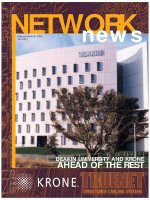Tài liệu ADC KRONE Network News - Vol.12 No.4 - 2005 doc
Bạn đang xem bản rút gọn của tài liệu. Xem và tải ngay bản đầy đủ của tài liệu tại đây (2.89 MB, 16 trang )
Vol12 No4 2005
Vol12 No4 2005
In this issue . . .
■■
Global Rush Toward IP Services Delivery
■■
ADC KRONE's New Fibre Solutions System
■■
FOXTEL Selects CopperTen
™
for Its New Sydney Headquarters
®
I
t’s my pleasure to share with you ADC’s third
quarter earnings results. The company had very
strong financial and business results once again
this quarter, the highlight being a 40% year-on-
year increase in sales. Similar to our second fiscal
quarter results, we continued in the third fiscal
quarter to deliver among the strongest year-on-
year growth in sales and earnings per share when
compared to most other communications
equipment suppliers.
Our breaking global news is that in August, we
acquired Fiber Optic Network Solutions (FONS)
Corp., a leading manufacturer of high-performance
passive optical components and fibre optic cable
packaging, distribution and connectivity
solutions. FONS is based in Massachusetts, USA.
With the addition of FONS, ADC is now one of
the largest suppliers of Fibre-to-the-X (FTTX)
solutions, according to proprietary market share
estimates. FONS has strategic partnerships and
outsourcing relationships in many countries
including Japan, China and the Americas.
With this acquisition, we can more fully
leverage our strengths to deliver on customer
demands for fibre in the central office, the
outside plant and at the customer premises. With
fibre being an increasing area of interest in the
Asia Pacific region, this will assist us in bringing
our customers the very best range of fibre
solutions.
In the last edition of Network News, we told
you about the FiberGuide
®
product, a new
addition to our TrueNet
®
portfolio. This edition,
Alan Crawford details the FL2000 fibre panels -
another fibre solution you might like to consider.
See page eight for details.
For our readers who are IT Managers,
I encourage you to take a look at Tim Takala’s
article on page four. Tim highlights some keys to
help you diagnose the source of issues within
your network based on a few common symptoms.
Cisco Networkers, held in September was a
great success and an event we value as a Cisco
Partner. It’s always a great opportunity for us to
touch base with our customers and update you
on the latest developments in our TrueNet
solutions.
With this being the last edition of Network
News for the year, I’d like to take this opportunity
to thank you for your continued support. We look
forward to serving you in 2006 with innovative
products from our expanding global portfolio and
continue to focus on meeting your customer
service needs.
Sincerely,
Bob Fitzgerald
2 ❙ NETWORKnews
A NOTE FROM BOB FITZGERALD
ADC KRONE News
8 FL2000 Fibre Solutions System
Technical Articles
3 Global Rush Toward IP Services
Delivery
4 It's the Duplex Stupid!
12 Proposed Method of Testing
Fibre Links
Customer Stories
7 Club KRONE Customer
Testimonial
10 FOXTEL Selects CopperTen for its
New Sydney Headquarters
14 TERMINATOR Gets Smart
15 TERMINATOR Turns up the Heat
Editor: Sarah Bishop
Art Direction: Nora Collins
Website: adckrone.com/au
CONTENTS
Copyright © 2001 KRONE Australia Holdings Pty. Limited
C
arriers and Enterprises are aggressively
deploying voice, data and video services
based on IP Infrastructures. Advocates believe the
move towards converged networks and the IP-
based circuitry that underpins them will enable a
host of applications that will be available to end
users on a wide range of fixed and portable
electronic devices.
This change will not happen overnight. Current
circuit-based networks must be transformed into
packet-based networks and in many cases
completely new infrastructure builds are
underway. However, when it is completed,
carriers, infrastructure providers and application
developers agree that the move towards of IP-
based networks will represent a seismic shift in
the telecoms landscape.
IP-based networks represent a fundamental
change of the telecommunications infrastructure
because its adoption involves taking apart the
vertically integrated elements of traditional circuit
switched networks. From a network engineering
perspective, this new structure is typically described
as consisting of three horizontal layers: a
technology agnostic ‘infrastructure layer’, a
‘switching and routing layer’ and an ‘application
layer’.
The intent of IP-based networks is to provide
the unifying platform that enables network
convergence, allows rapid deployment of new
services and, because they are based on open
standards, keep costs down.
To deliver the complete mix of IP-based
services, every carrier must evolve all areas of the
services delivery - Wireless Services, Residential
Services and Business Services. Carriers are rolling
out initiatives in four areas to enable the new IP
services:
■
Circuit to Packet infrastructure migration in
the network core
■
Deep Fibre using Fibre-to-the-X (Node, Curb,
Premises) for delivery of broadband services
■
Wireless IP-based networks for advanced
data and video services
■
IP-based high speed business services delivery
Given the future impact of these Carrier
infrastructure initiatives, Enterprises need to take
a close look at their requirements to leverage the
carriers’ new IP-based networks. There are many
reasons for this. Medical imaging and file data
transfer is increasingly growing. Network storage
is becoming increasingly critical. Grid & cluster
computing is gaining adoption in public and
private sectors, and we are seeing an increase in
next generation enterprise applications such as
RFID, IP Factory networks and Intelligent
Buildings. As a result of these changes, more
throughput and signal integrity will be required.
With 10-Gigabit Ethernet over copper coming to
routers/switches in 2006, end-users again have
the opportunity to prepare themselves for their
future needs.
■
NETWORKnews ❙ 3
GLOBAL RUSH TOWARD IP SERVICES
DELIVERY
Why Enterprises need to look at the developments in the
telecommunications space to prepare themselves for the future.
Carsten Quiram,
Marketing Director,
Asia Pacific
Wireless Services
Residential Services Business and Enterprise Services
Every service provider and enterprise must evolve all areas of the network to deliver a new mix of IP-based services.
N
othing they teach you in a textbook can
replace experience from the field. The same
thing also holds true for the saying “Mechanics
are only as good as their tools”. If there’s one
thing time has taught me from the field it’s that
the only constant is change.
There was a time when the only way a
structured cabling manufacturer could
differentiate was to say “my headroom is bigger
than theirs”. That’s when everything was based
on dB values. Then came claimed frequency
range, where companies were playing “Name
That Tune” with extended frequency response.
“If you claim you can work to 350MHz, than I’ll
claim 400MHz” surely this must be better, right?
How confusing for the network administrator.
“Who do I believe? What’s really important? How
do I choose the best solution for the money?
Which vendor is telling me the truth? I just want
my network to be reliable! I don’t talk Megahertz,
I talk Megabits!”
If you want to make an IT guy’s head spin
simply start throwing out acronyms/terms like
PSELFEXT or Attenuation to Crosstalk Ratio. Do
you really want to know whether the cable is
good? The answer is much simpler than you think
and lies in one question. Does the network run at
its full potential?
What is the fundamental task of the network?
It’s the transport and storage of data and has
nothing to do with dB’s of headroom! It’s
important to remember that every network is as
individual as the people supporting it. Networks
are almost human. They’re a living, breathing
series of components transporting data through
veins (cables), working to ensure the business
thrives.
Many years ago, ADC KRONE (then KRONE)
adopted this philosophy and as a result has
gained a great deal of knowledge on what really
matters to the network administrator. Through a
series of excellent networking tools and a good
working knowledge of networking fundamentals,
we started a journey to understand the real
concerns the IT departments faces daily. As a
result, in 1999 ADC KRONE’s ZeBER* was
launched. ZeBER bridged the gap between the
structured cabling manufacturer and network
administrator perspectives. The argument was
taken away from Megahertz and more emphasis
was placed on reliable transmission of Megabits.
Testing was conducted in the field, after the
network was up and running, to ensure data was
flowing throughout the network reliably.
Fortunately the tools we deployed not only told us
how well the cabling infrastructure was working,
they also told us a great deal about the active
components.
There’s a misconception that cabling is
responsible for most of the problems within the
network infrastructure. As the cable guy I’d like
4 ❙ NETWORKnews
IT’S THE DUPLEX STUPID!
Ti m Takala unveils some common misconceptions on the causes of
network errors.
Tim Takala, Corporate
Business Manager
It’s important to remember that every
network is as individual as the people
supporting it. Networks are almost human.
They’re a living, breathing series of
components transporting data through
veins (cables), working to ensure the
business thrives.
*With ZeBER= Zero Bit Error Rate. With the related warranty, ADC KRONE guarantees that the physical layer infrastructure will
cause no greater than 10-
12
bit errors per second.
nothing more than to be able to tell you that this
is true, but it’s not. Any good IT guy worth his salt
will see right through this argument and tell you
“it’s the duplex stupid”!
When monitoring a network using SNMP,
several different types of errors can and will be
found, depending on circumstance. CRC’s
(cyclical redundancy check, also known as FCS
errors), fragments, collisions, jabbers, runts,
oversize, misalignments and the list goes on and
on. If the network is a living and breathing entity
than these are the symptoms of sickness. Being
able to diagnose what is causing these symptoms
comes from experience.
Typically when CRC errors are present, from a
textbook perspective, it is due to an issue on the
physical layer i.e. the cabling and connectivity.
This is where the textbook needs to be put down,
where common sense and experience need to
take over. Different types of active hardware from
different vendors will report errors differently.
Remember when I said that the only thing
constant is change. This holds true for active
hardware manufacturers. Not only is different
manufacturer’s equipment designed differently,
equipment from the same manufacturer can also
be very different functions and report errors.
When it comes to CRC errors, what you see on
the surface can be very deceptive. This error type
is the most prevalent within networks and the
reason for the misconception that the cable
causes most errors in networking, but if you look
below the surface you will find a completely
different answer.
Bear in mind that a good cabling infrastructure
is the foundation of the network. Electrical
problems with the cabling can manifest
themselves as errors in the active hardware, but
that’s why we test the cable during installation.
Compliance with cabling standards gives
confidence that the protocols supported will work
with little or no issues. ADC KRONE’s impedance
matching philosophy took this to an even higher
level.
So, why do I have CRC errors if the cable is of
a good quality? First you need to understand
what a CRC error actually is. Imagine that each
packet of information you are transmitting on a
network is a letter. It has a source address, and a
destination address, contains information and it
NETWORKnews ❙ 5
What is the fundamental task
of the network? It’s the
transport and storage of
data and has nothing to do
with dB’s of headroom!
also has a built-in spell check - CRC. When the
letter reaches its destination the recipient checks
the packet to ensure that the spelling (CRC) is
correct. If a single bit is out of place the
letter/packet is rejected and needs to be sent
again, hence an error has occurred. While the
cabling can cause bits within a packet to become
corrupted, typically the cause is from a different
source. ADC KRONE’s TrueNet
®
portfolio cabling
will ensure this holds true.
Active hardware manufacturers do differ in the
way they make equipment. Even equipment from
one manufacturer can have very different
equipment designs. This can create issues in the
way conversations between ports are set up. In
networking there’s something called duplex.
When two devices are connected in order for a
conversation to take place three things must
happen first.
1. They must speak the same language i.e.
Ethernet, ATM, TokenRing etc.
2. They must talk at the same speed i.e.
10BASE-T or 100BASE-T – whichever is the
highest common denominator.
3. They must decide if they can handle
speaking at the same time (full duplex) or if
both devices require that only one speaks at
any given time (half duplex).
While the first two are fairly simple, the third
can be very problematic. With regard to duplex,
devices are meant to connect at the highest
common denominator. However, sometimes
things don’t work out as planned. When the
handshake is made between two devices, if the
duplex gets “confused” a mismatch will occur.
Conversation is still possible, but not without
errors and the need for retransmissions. This is the
single largest cause of errors in networking today!
So what do you do if you find you have
excessive CRC errors on your network? The first
thing to check is if there are also collisions being
detected. If you have collisions/misalignments on
a switched network there’s a more than high
chance the issue is due to a duplex mismatch.
Next, check configuration! If one side is set to
auto-negotiate and the other to full duplex this
can cause the auto-negotiate side to cycle down
to half. When both sides are set to auto-negotiate
mismatches can still occur, even on same
manufacturers’ devices!
I was recently onsite at a large University testing
their network. I was surprised at how well the
network was running, with no errors found on
the entire campus in a four hour test period. Then
I found out why. On the back of the door in the
data centre a sign was posted “It’s the Duplex
Stupid”! Seems our institutes of higher learning
have taken to also teaching practical common
sense.
■
6 ❙ NETWORKnews
There’s a misconception that
cabling is responsible for
most of the problems within
the network infrastructure…
Any good IT guy worth his
salt will see right through
this argument and tell you
“it’s the duplex stupid”!
I am always interested in receiving feedback about Club KRONE
so we can look at ways to improve the current scheme and provide
more benefits to our installers. T ony Arnold of Arnolds Electrical &
Data Installations, a 3 year Club KRONE member , talks about the
benefits his business receives from Club KRONE.
NETWORKnews ❙ 7
CLUB KRONE CUSTOMER TESTIMONIAL
Mark Meyer, Manager
Club KRONE
A
DC KRONE’s FL2000 fibre panels are a
flexible, modular and economical series of
fibre products for today and tomorrow’s evolving
communications and data networks in both
Enterprise and Carrier networks. The FL2000 is
designed for 19” or 23” rack systems, however all
panels are wall mountable. A variety of options
and accessories ensure compatibility with existing
optical equipment.
FL2000 panels provide termination, splicing and
storage capabilities for in-building cables, outside
plant cables, and fibre equipment patch cords. The
termination panels are hinged on one side, allowing
full access to the rear of the front plate and the
interior of the panel. All panels accommodate the
modular FL2000 6-pak plug-ins available in all
standard connector styles. The FL2000 product line
includes a complete line of storage panels, cable
troughs, and accessories. Panels are available empty
or preconfigured at the factory.
As a termination device, the connector panels
provide mounting points for 12 to 96 bulkhead
adaptors. A variety of adaptors are available to
ensure compatibility with existing connectors and
equipment. Also, both single mode and
multimode (62.5/125µm) fibres are available.
As a splicing device, the splice panels permit
splicing up to 48, 96 or 144 fibres in a centralised
location. The splice modules use modular splice
devices that allow many splicing methods.
As a termination/splice device, the
termination/splice panels provide interconnect
capacities for 12, 24, 48, 72 and 96 fibre
terminations. The upper section of the panel is
equipped with a bulkhead panel, hinged at the
left and latched at the right, to provide access for
8 ❙ NETWORKnews
Introducing the FL2000 product range, ADC KRONE’s advanced fibre
patching system, available in multiple configurations. This solution is
ideally suited to all Enterprise and Data Centre applications.
Alan Crawford, Product
Manager Carrier
Connectivity, Wireless &
Wireline
FL2000 FIBRE SOLUTIONS SYSTEM
The FL2000 6-paks feature
ADC KRONE’s patented,
removable angled retainer
for bend radius protection
and easier hand access to
the connector.
a 6-pak intallation and cable routing. Pigtail fibres from the 6-paks are
routed to splice decks in the lower section of the panel for splicing.
The FL2000 fibre panels have numerous cable management features
to protect bend radius and provide easy access to connectors. Each
panel comes with its own vertical cable guide (VCG) to protect fibres as
they transition in and out of the panel (bend radius) as well as to
provide an enclosed space for vertical transition. Fibres within this VCG
are less likely to be damaged by nearby personnel than if they were
hanging openly from the panel. The FL2000 6-paks feature ADC
KRONE’s patented, removable angled retainer, angling each adaptor at
45 degrees. This provides bend radius protection for the cables
attached to the bulkhead, access to both sides of the connector, and
easier hand access to the connector.
The economical and flexible FL2000 series of fibre optic products is
ideal for small fibre counts and can be used in moderate fibre count
applications as well by combining various panels.
■
NETWORKnews ❙ 9
FEATURES
■
A complete line of modular panels
developed for cabinet, rack and wall
mounting.
■
Fully adaptable for large or small main
distribution frame (MDF), intermediate
distribution frame (IDF) or telephone
closet (TC) applications.
■
Designed for 19” and 23” rack or
cabinet environment.
■
Provides termination, splicing and
storage capabilities for in-building
cables, outside plant cables and fibre
optic terminal (FOT) equipment patch
cords.
■
Modular design offers maximum
flexibility to satisfy both current needs
and future growth requirements.
■
A full line of options and accessories
ensures compatibility with existing
optical equipment.
■
FL2000 systems accommodate the
value-added plug-in modules, adding
flexibility and functionality to the optical
transport systems. Splitters, wavelength
division multiplexers (WDMx) and other
optical components can easily be
incorporated.
■
All FL2000 panels accommodate the
modular FL2000 6-pak plug-ins. These
are available in all connector styles and
can be ordered as needed.
■
ADC KRONE’s patented removable
angled retainers allow easy access for
single fibre maintenance.
■
FL2000 panels feature superior vertical
cable protection and management.
■
Rack mount panels are hinged on one
side, allowing full access to the rear of
the front plate and the interior of the
panel.
■
Rack mount panels can be wall
mounted.
■
The new FL2000 splice wheel allows
easy roll-up of pigtail and buffer tube
lengths and superior bend radius
protection.
■
The FL2000 splice deck is available to
complete existing installations.
F
OXTEL’s corporate data and telephony services
are delivered over IP and the majority of
broadcast system have some component
connected to IP networks so quality network
infrastructure is critical. The services delivered
across the converged network are diverse. The
new site consists of four buildings, hence the
flexibility and performance of the cabling solution
was paramount.
The company commenced a major relocation
from Pyrmont to North Ryde in August 2005. As
a result, FOXTEL needed to integrate their existing
network infrastructure into the new building and
facilitate the expanding needs of the high-tech
organisation.
The North Ryde site was designed with four
outlets running to each desk. The ADC KRONE
solution consists of three Category 6 connections
and one CopperTen
™
connection. The computers
are plugged into the CopperTen outlets as they
require a large amount of bandwidth for graphic
design and video streaming. In the comms room,
Category 6 is terminated on HighBand
®
25 (900
pair wall mount frames) and CopperTen is
terminated on CopperTen™ 20 (720 pair frames).
In addition, there are Cat 6 and CopperTen
system tails to the switches.
Simon King, network architect for FOXTEL
explained the selection process for the new
network. “The two deciding factors in selecting a
solution were performance and suitability to our
needs. Availability of product was crucial due to
short business timelines. We needed a flexible
solution since we have different uses for the
horizontal cabling. The solution also needed to be
as ‘future-proof’ as possible given the long-term
intentions for the site.” Said King.
Rencom’s Wayne Hill described the challenges
of the installation. “The installation was unique in
that we required a hybrid of existing horizontal
cabling termination systems. Some services
needed to be permanently wired, being
ubiquitous across the site and managed via
software. Other services are still managed by
physical patching, being specialised or adhoc. The
bandwidth requirements also vary across services
and ADC KRONE’s offerings allowed us to
affordably provision for estimated future
requirements.” Said Hill.
FOXTEL were pleased with the outcome, “ADC
KRONE’s frame termination meant we could meet
both our termination needs consistently across
the multiple buildings and effectively deliver more
points within budget. The wall mounted frame
solution saved a great deal of floor space, which
was much needed. Hard wiring and rear facing
PBE leads keep the frame neat and tidy.”
Commented King.
10 ❙ NETWORKnews
FOXTEL SELECTS COPPERTEN FOR ITS NEW
Jeremy Barnes, Sales
Executive
FOXTEL, Australia’s leading subscription television provider, began a
relocation of its Sydney-based premises in August, using ADC KRONE
solutions for the updated network infrastructure.
Left to right:
FOXTEL’s Simon King
and Andrew Heyes,
Rencom’s Wayne Hill
“The computers are plugged
into the CopperTen
™
outlets
as they require a large
amount of bandwidth for
graphic design and video
streaming.”
Asked why Rencom selected an ADC KRONE
solution, Hill remarked “I have only used KRONE
products for some years now as I find the
performance and quality of the product to be
superior. I installed the Highband 25 product on
the FOXTEL project and I have long been a fan of
this solution as it yields very high test results and
is extremely easy to install and it exceeded all
expectations on the difficult FOXTEL installation.”
Said Hill.
When asked how he felt about the
performance of the solution, FOXTEL’s Simon
King was pleased to say, “Excellent. We have had
flawless high performance well above the current
requirements. It was fantastic to be able to
relocate a large group of people and not have a
single cabling issue or complaint regarding
connectivity.”
FOXTEL’s relocation is still underway, with
completion expected in December 2005.
■
NETWORKnews ❙ 11
NEW SYDNEY HEADQUARTERS
“The solution also needed to
be as ‘future-proof’ as
possible given the long-term
intentions for the site.”
T
he proposed new International and
Australian/New Zealand Standard for testing
of Optical Fibre links will have a new method of
setting the ‘Zero’ Reference Setting for all Light
Source and Power Meter testers. The current 1-
Test Cord Method of reference setting will give
way to a new option called the 3-Test Cord
Method.
The 3-Test Cord Method for reference setting
and measurement of Optical Fibre (OF) Links is
technically better and more accurate than other
methods like the 1-Test Cord Method or the 2-
Test Cord Method or any modified methods.
LAUNCH, TAIL AND FIELD CALIBRATION
CORDS
The 3-Test Cords for reference setting (zeroing)
are;
1. Launch Cord
2. Field Calibration Cord
3. Tail Cord
The Field Calibration Cord has high-
performance Reference Connectors on both ends
connecting to the Launch and Tail Cords. The
Launch and Tail Cords have high-performance
Reference Connectors on the ends connecting to
the Field Calibration Cord and Connectors suited
to the test metres on the other end.
After the reference is set to ‘zero’ dB using the
3-Test Cords, the central Field Calibration Cord is
removed. The Launch and Tail Cord Reference
Connectors are then plugged into the Link under
test. Because the Link under test is now being
measured with Reference Connectors, the
allowable loss in the Power Loss Budget is now
only 0.30 dB per connector pair for MMF and
0.50 dB for SMF, instead of the usual 0.75 dB for
MMF and SMF non-reference connectors.
The Power Loss Budget is (2 x 0.30 = 0.60) dB
+ (loss of any splices and the MMF link) dB.
Tester manufacturers will have to change their
tester software to allow for the insertion loss of
0.30 dB and 0.50 dB per reference-connector
pair.
WHY IS THE CHANGE TO THE 3-TEST
CORD METHOD NECESSARY?
As OF networks move to higher data
transmission rates like 1 GBE and 10GBE, the
Power Loss Budget becomes the critical factor.
The maximum allowable Power Loss Budgets
according to ISO/IEC 11801 are :
■
1GBE 2.60 dB Loss (maximum)
■
10GBE 2.20 dB Loss (maximum)
The single biggest contributors to power loss in
the link are the fibre connectors.
12 ❙ NETWORKnews
PROPOSED METHOD OF TESTING FI
3-TEST CORD METHOD FOR REFERENCE SETT
Peter Meijer, JP BE MSc,
RCDD, Technical
Manager Industry
Support
Peter Meijer details the proposed 3-test cord method of reference
setting for fibre optic links.
NETWORKnews ❙ 13
ADC KRONE’s FiberGuide
®
is the industry’ s
most comprehensive optical raceway system.
It is a trough system designed to protect and
route fibre optic patch cords, multifibre
cable assemblies and infrastructure fibre
cable.
The FiberGuide System is a complete set of
products designed and manufactured to
ensure total off-frame protection.
FEATURES:
■
Available in a range of sizes including
50mm, 100mm, 150mm and 300mm.
■
Minimum bend radius protection for the
fibres.
■
Speed of installation - The FiberGuide
system features a variety of products that
enable quick installation.
■
Express-exit points are easy and quick to
install allowing flexibility in where the
fibres exit the raceway system.
FIBRE LINKS
SETTING (ZEROING)
FiberGuide
®
The 3-Test Cord Method with its Reference Connectors
and tighter tolerances (like 0.30 dB per MMF connector) has
the ability to quickly detect:
■
Poor connector cleaning prior to testing or patching
■
Poor field polishing during installation
■
Poor quality connectors
■
Unacceptable or angled faces on connector ends.
All of these things degrade the performance of the optical
link and reduce data transfer rates. So the introduction of the
3-Test Cord Method of Reference Setting will result in better
optical fibre links and the highest possible data transfer rates.
It is planned to include the 3-Test Cord Method for
Reference Setting in the new ISO/IEC AS/NZS 14763-3 -
Testing of Optical Fibre Cabling - in 2006.
For more info visit www.adckrone.com and look under
Technical Papers for Draft Performance Testing of Optical
Fibre Links. 3-Test Cord Method.
■
Testing with 3-Test Cord method in the field.
K
ristil Technologies is an Australian-based
provider of home automation systems. The
company has pioneered ‘smart’ residential
systems, producing Home Control Packs, which
enable automation within the home for phone,
data, electrical devices, lighting and more.
Kristil has always had a philosophy of ‘Do it
once, do it well and do it smarter’ and that
philosophy brought ADC KRONE TERMINATOR to
Kristil hub boards.
Home automation requires a high level of
planning that can appear complex to the
uninitiated. In the past few years, Kristil
have been making the wiring and
terminating part of the job as easy and
foolproof as possible.
Kristil’s research found that terminating hub
boards accurately was a time consuming task. As
a result, they trialled ADC KRONE’s TERMINATOR
system in Western Australia with great success
and have implemented it throughout Australia
and New Zealand.
Manhattan Electrics’ Adam Bokos was thrilled
with the Kristil board. “I cannot believe how quick
and simple it was to terminate Kristil’s dimmer
boards. Compared to any other board the
termination time was halved and the fact that
each TERMINATOR
has ten marked
terminals makes it
very easy to tell which
terminal to terminate
the correct cable to.”
Bat Electrics’ Ben
Grist recently installed
his first Kristil board
using ADC KRONE
Terminators at a job in
Beaconsfield, Victoria
and was rightly proud
of the finished job.
“The job came
together very well and
our client who is an IT
manager with CSIRO
liked the professional
look and approved of the ADC KRONE punch
down philosophy, a method he uses all the time.”
Kristil Technologies’ CEO, Ross Campbell said
he was unsure it was a good idea publishing a
story on the use of ADC KRONE technology. “It
gives Kristil’s competitors the opportunity to steal
another of our good ideas, but in the end, I
believe using an ADC KRONE insulation-
displacement terminating module for 240-volt
wiring is a fundamental shift from over a hundred
years of using screw terminals and will be the way
most switchboards will be manufactured from
now on. It is fast, accurate and aesthetically
pleasing.”
■
14 ❙ NETWORKnews
TERMINATOR
®
GETS SMART
With the increasing market demand for home automation, Kristil
Technologies have incorporated the TERMINA T O R into their smart
home technology.
Jeff Glen, Manager,
Power and Control
Products
The job came together very well and
our client who is an IT manager with
CSIRO liked the professional look and
approved of the ADC KRONE punch
down philosophy, a method he
uses all the time.”
B
eech Ovens began producing wood-fired
pizza ovens 15 years ago, catering to the
emerging demand for the gourmet delight. Now
in huge demand across many countries, with 75
percent of its business from export markets, the
Brisbane-based company makes and supplies
specialty ovens to some of the world’s leading
restaurateurs, luxury hotels, kitchen designers
and franchise chains.
Neil Beech, the company’s gas specialist,
explained the evolution of the Beech pizza oven
technology. “We were using screw terminals in
the control panel, which take up unnecessary
space and time to install. We got to a stage
where we needed a more compact solution and
that’s when we discovered the ADC KRONE
TERMINATOR solution”. Commented Beech.
“TERMINATOR was a faster and more flexible
solution, allowing us to introduce design
complexities and complete the termination much
faster. We are now saving 75% of the time we
were spending using the screw terminals.”
The TERMINATOR system is used for
connecting the control cabling and uses ADC
KRONE’s patented Insulation Displacement
Connection (IDC) technology. This method does
not require any wire preparation prior to
termination. A modular system, TERMINATOR is
easy to use and allows great flexibility for
additions. The module quickly and easily clips on
to DIN rail, saving time.
“When I was using screw terminals, I would
check each connection to ensure the wire was
fully terminated. Now with TERMINATOR, I don’t
have to spend time on quality control, it’s a
foolproof solution which guarantees my products
are reliable.” Remarked Beech.
The TERMINATOR module can be used for
connecting solid, stranded or flexible copper
wires ranging from 0.34mm2 to 2.5mm2 as well
as the ability to interface between both wire
ranges with insulation levels up to 0.6/1kV. The
system is built around a 10 wire position or 3 wire
position module available in a through or
disconnect version. An extensive range of plug in
accessories, together with the unique wire
termination tool make up the TERMINATOR
system. The ADC KRONE IDC contact bites
directly into the virgin copper under high pressure
giving a gas-tight seal.
To find out more about how you can save time
and expense with the TERMINATOR solution,
please contact your local ADC KRONE sales
representative.
■
NETWORKnews ❙ 15
TERMINATOR
®
TURNS UP THE HEAT
TERMINATOR has proven to be the hidden gem inside Beech Ovens’
world-class wood-fired pizza ovens.
“We got to a stage where we
needed a more compact
solution and that’s when we
discovered the ADC KRONE
TERMINATOR solution.”
I NEED ONE TRUE NETWORK
INFRASTRUCTURE SOLUTION.
TrueNet is the high-performance
structured cabling solution that meets
your unique network needs. Your one true
network infrastructure solution, TrueNet is
the integrated portfolio of industry-leading
products from ADC KRONE.
T rue End-to-End Solution
Now your complete network
infrastructure needs are met by a single
global manufacturer. The TrueNet system
delivers proven cable, connectivity, and
cable management solutions for fibre,
10G Ethernet over UTP, and Category 6/5e
from the data centre to the desktop.
T rue Performance
With TrueNet, you can push networks
to the performance edge. Innovative
products that exceed industry standards
support advanced applications today
and tomorrow.
T rue Reliability
Mission-critical networks rely upon
trusted TrueNet infrastructure. Built
and tested in ADC KRONE's world-class
facilities, TrueNet guarantees signal integrity
and network throughput.
I need TrueNet
®
AUSTRALIA
2 Hereford Street, BERKELEY VALE NSW 2261
Ph: (02) 4389 5000 Fax: (02) 4388 4499
TECH SUPPORT: 1800 801 298
WEBSITE: adckrone.com/au
NEW ZEALAND
Cnr The Esplanade & Nevis St, PETONE NZ
Ph: +64 4 576 9213 Fax: +64 4 576 9243
SALES: 0800 657 663
WEBSITE: adckrone.com/nz









